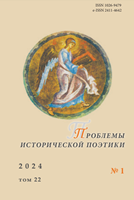Концепция трагедии Шекспира в литературной критике Ю. Айхенвальда
Yuly Aykhenvald’s Concept of Shakespeare’s Tragedies
Author(s): Dmitry N. Zhatkin, Vera V. SerdechnaiaSubject(s): Theatre, Dance, Performing Arts, Aesthetics, Russian Literature, Theory of Literature, Sociology of Art, British Literature, Sociology of Literature
Published by: Петрозаводский государственный университет
Keywords: Shakespeare; Yuly Aykhenvald; Shakespeareanism; Shakespeare’s tragedies; Shakespeare’s reception; literary criticism; immanent criticism; Shakespearean studies; literary archetypes; Hamlet; Caliban; A
Summary/Abstract: The authors analyze the Shakespearean studies by Yuly Aykhenvald (1872–1928), a famous literary critic who substantiated the method of immanent criticism and is better known as the creator of Russian writers’ “portraits.” The purpose of the work was to consider and streamline the principles of analysis of Shakespearean images in Aykhenvald’s legacy. The objectives of the work included identifying the main images for the critic in Shakespeare’s tragedies; analysis of the principles of his criticism; identifying the ideological foundations of criticism. Results of the work: Aykhenvald considers Shakespeare’s tragedies a timeless phenomenon, telling us not so much even about the life of the human spirit, but about the laws of the development of the world. Aykhenvald interprets Shakespeare as a sage immersed in the truths of world dualism as a Neoplatonic teaching of the Gnostic persuasion. The critic sees in Caliban the embodiment of crude matter (which then makes it possible to liken him to the Bolsheviks with their materialistic philosophy), in Ariel he sees pure spirituality, and in Hamlet — the transitional period of human existence between them. Hamlet is understood by Aykhenvald as the central Shakespearean character, a kind of archetype of the Shakespearean hero, reflected in the others: Lear, Romeo, Macbeth. Hamlet is also considered by Aykhenvald to be an image of our contemporary, with his inherent dominance of reflection and inaction. However, Aykhenvald expresses the hope that beyond the Hamlet stage, humanity will reach a spiritual existence, which is symbolized by Ariel.
Journal: Проблемы исторической поэтики
- Issue Year: 22/2024
- Issue No: 1
- Page Range: 209-228
- Page Count: 20
- Language: Russian

